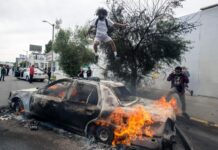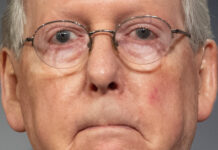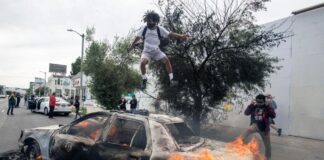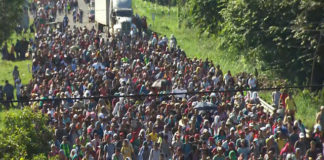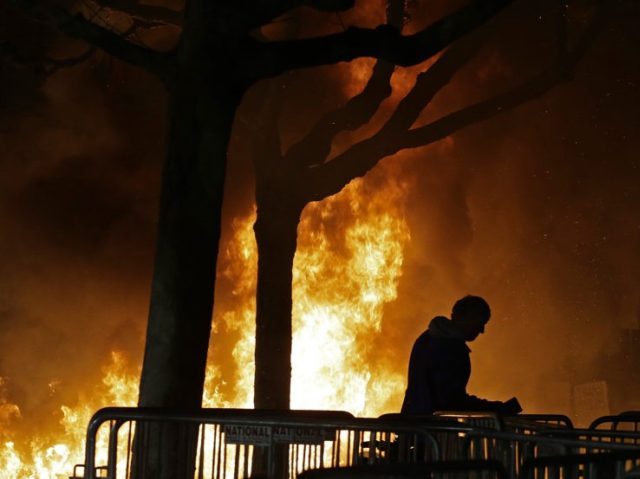
Eye-rolling dismissals of the rabid Party Line dogma pervasive in academia and the fanatics it’s producing is a dangerous denial of what the future holds for America
By Mark Cromer
To paraphrase Alice Cooper: school’s about to be out—and probably not a moment too soon.
This historic season of discontent that has enveloped the nation also smoothly coincided with the 2016-2017 academic calendar, with colleges and universities welcoming back their students last fall just as the presidential campaign entered its final stretch and then came to its earthshaking crescendo.
And so America was treated to campuses that were quickly converted into campaign consulates complete with comfortable barracks for the shock troops that the Democrats believed would drive their ground game and deliver their Madame Secretary to her rightful reign at long last, even if many students were less than enthusiastic about another President Clinton. But as November 8th ebbed away into the greatest political upset in American presidential history, the campuses became something of a public address system, nationally broadcasting the weeping, wailing and wild-eyed shrieking that swept the academy from Harvard to Stanford, from Georgetown to Berkeley.
It was a collective cry of anguish that spawned one of the most ironically fitting social symbols of the Millennial era: The Safety Pin—as in the kind parents once used to fasten diapers on their infants. Suddenly appearing across social media platforms much in the same way the French tri-colors filter did in the aftermath of the ISIS terror attacks in Paris in November 2015, the sudden ubiquity of the safety pin among many on the Left was their way of declaring: ‘Je suis Hillary! Donne moi ma bouteille!’
Following a holiday respite that was all too short, the students returned to campus from winter break as the inauguration of President Donald J. Trump growled through the Beltway like rolling thunderclaps following the lightening strike of his election, a jolt that electrified students to life and brought them once more into the public square to protest, well, everything it seems. And it has been an odd juxtaposition to say the least—with as many as 93-million Americans or more no longer participating in the workforce—to see students of every racial stripe and of both genders who enjoy an inheritance of comfort, privilege and opportunity their grandparents could scarcely have imagined whip themselves into a lather over such things as: ‘Cisgendered constructs of institutional oppression that continue to facilitate conventional and unconventional forms of aggression targeted at marginalized communities long known and others not yet identified.’
It is to this rich vernacular that so many college students now peacock and pose as they protest about how the working class men and women who set this lush national table for them are now, by their very nature and cultural disposition, the enemy. They gaze upon this vast geographic sweep of America that unfolds between the seaboards and is largely populated by the nearly 65 million citizens who voted for Trump and their families and they see, in the words of Boston University’s Saida Grundy, a ‘problematic population,’ which in the dog-whistles of academia passes as social etiquette for identifying them as cognizant-deficient swamp people that were led into polling stations by Trump 2016 as if they were going to WWE’s WrestleMania.
And as university students continue to convulse over Trump’s election, the central issue at play behind their kaleidoscope of objections and their dizzying lists of demands is truly what will be the fate of more than one-third of the population of the United States of America.
Given their fondness for framing their actions and their objectives against the epic struggles of the mid-20th Century, perhaps that fate is now being addressed in the very same language of that period in the faculty lounges and amid the racial set-asides of the ‘safe spaces’ on campus. Perhaps here the ultimate solution to ‘the Anglo question’ and its associated ideological and cultural dilemmas is being formulated even as you read this.
While they fancy themselves in public as ‘The Resistance’—a characteristically over-the-top and utterly unfounded collective christening replete with nom de guerres and ‘blocs’ and ‘fronts’ and ‘mobilizations’ and other romantic reflections beaming back at them from their iPads—the stunning historical disconnect is apparently lost on them or perhaps, as they are so often wont to accuse others of, they are brazenly appropriating a historical struggle for their own aggrandizing amusement.
But lets be clear, this is not Paris in the dark years of 1940 to 1944, they are not Albert Camus writing in a basement by candlelight for the next issue of Combat, a publication of which the mere possession of was a death sentence in Nazi-occupied France. While many of them hide behind masks, it is not a reaction to a ‘Nacht und Nebel’ decree that is seeing thousands simply disappear from campus or off the streets, but rather merely to disguise their identity while committing garden variety criminal acts of vandalism, assault, looting and arson.
This is neither resistance nor rebellion, but rather the emergence of a grim New Order that seeks to silence and subjugate not only all who dare oppose it, but to monitor those suspected of even being slightly less than enthusiastic and setting upon them at the first sign that they aren’t vocally simpatico with its agenda.
No, not all students striding across commencement stages this spring are violent Left-wing stooges who enjoy window smashing as much as their parents enjoy window-shopping, any more than all of their underclassmen are easily herded dupes willing to march, chant and flash mob at the drop of a text.
But nor are they mere academic bystanders, quiet class-goers who choose to simply find a study-break as a vocal minority stirs up trouble in the shadows on and just off campus. Heretical speakers and thinkers like Ann Coulter that are violently kept off campus or are shouted down are not the victims merely of hecklers peppered throughout crowds preprogrammed to agitate at the most opportune time, but rather they are attacked in every manner because of the campus climate, operating structures and the majority of the student population at almost any given college have permitted it—and therefore support it, whether tacitly or triumphantly.
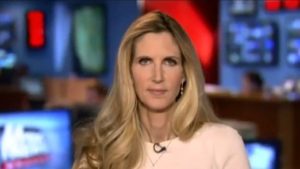
Like those before it and those that will follow in the years to come, the Class of 2017, by and large, is accomplice to an escalating war against not only freedom of speech—which on some campuses now is being defined as a misnomer that was merely a historical weapon forged by America’s founders to advance and safeguard white male patriarchy—but also an accelerating blitzkrieg on freedom of thought, freedom of expression and freedom of association.
And yet the real danger rests not among the students that now effectively run the very campuses that produced them, nor the administrations that accommodate them or the faculty that have long been political code-writers and programmers that ideologically groom them for their future tasks, but rather the greater threat is a drastically misplaced belief among an evermore distracted civil society that the insidious-turned-violent suppression of speech, philosophy and free association will somehow end at the campus gates or shortly thereafter.
Like a child’s insatiable sweet tooth that tends to disappear with the passing of adolescence, the prevailing thought among many Americans today seems to be that students’ taste for making demands, issuing diktats and expecting not only compliance but celebration in return will magically evaporate as they find their way into and through the ‘real world.’ It’s a belief predicated in part on the assumption that the old grindstones that have traditionally sanded away the sharp excesses of youth—the professional responsibilities that come with the launching of a career and the personal responsibilities that are demanded when starting a family or the desire to make ones own way in life following college or military service—will continue to prove to be more powerful than four or more years of academic indoctrination and genuflecting accommodation.
It won’t.
Those forces no longer exist in American culture at least to the degree they once did, nor for that matter does the very country that once applied them with such breathtaking success during the Post-War era that it produced a vast middleclass never before seen among nation-states. That America cannot and will not be remade or returned to again, anymore than a 55-year-old can awake one morning to find him or herself back in their mid-20s prime. It’s a sweet dream and full of fond memories of a time that was very real and led us in part to where America stands today, but that ship of state has sailed over the horizon in this world to never return.
The question is what happens now and tomorrow and the day after that in a deeply fractured country where according to the National Center for Education Statistics more than 20.5 million students attended college this academic year, enrolling into a surreal landscape where seething contempt for the historically dominant culture and its now ritualized degradation has been codified into the curriculum.
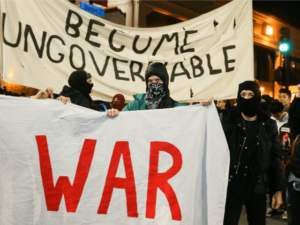
This is not a phase students are going through, but rather uncharted waters the nation is heading into as the intellectual elite of the Millennial Generation and the one that follows it—‘The Plurals’ as AdWeek dubbed them—continue to flow en masse out of the campuses and into a polyglot American cultural tinderbox.
The tendency among conservatives and many liberals is to collectively roll their eyes, clear their throats and shake their heads somewhere between bewilderment and disgust at the violent chaos that has exploded on campuses and their surrounding communities over the mere prospect of someone speaking unapproved thoughts in unapproved language. Conservatives mock and ridicule these spectacles as signs of how intellectually coddled college students have become, often treating people being punched as a punch line to joke about the Left and the uniformity that defines an academy that can’t complete a sentence without the required lines: ‘the richness of diversity.’
Most clear-eyed liberals still seem to insist on discussing it as unfortunate excesses unfolding on the fringes of righteous marchers and rooted in the toxic brew of social injustice that’s exploited by a handful of rabble-rousers and agitators out for their own gain, whatever it is that might be. The successive upheavals at Cal Berkeley finally prompted such lefty stalwarts as Senators Bernie Sanders and Elizabeth Warren to mutter a few words about the importance of civil discourse, yet even those feeble chastisements were caveated with concern that unabashed mob thuggery only plays into the hands of sharp writers like Coulter, flamethrower performance artists like Milo Yiannopoulos or staid intellectuals like Charles Murray.
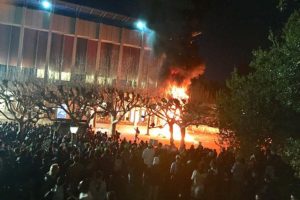
So, as Warren and Sanders and other left leaders apparently see it, mob violence is not so much wrong because it’s wrong, but rather it’s inadvisable in such situations because it ultimately assists the people its directed at in affirming an unflattering narrative about the violent mob. If that same logic were applied to the frothing white crowds that physically attacked black students attempting to enter high schools or colleges in a desegregating South or Northeastern cities like Boston in the 1960s and ‘70s then those contorted-faced thugs were misguided because it only helped the rest of the nation solidify their negative opinion of Southern whites and their Northern enclave cousins, not because it was racist and wrong on the face of it.
But the collective reaction from establishment conservatives and liberals alike to the ideological conformity that has solidified on the nation’s campuses and the street terrorism it is now fueling off campus, framed as it has been in acceptance as long as it doesn’t impact them directly and lacking any sense of urgency that would indicate they actually grasp the true nature and depth of the threat it poses to what remains of the fragile threads that bind our country together, is now the even greater danger to America.
An unwillingness to accept that students chanting that ‘the only good cop is a dead cop’ actually believe it and mean it has consequences.
A determined ignorance of what the ramifications are of students declaring without hesitation that speech they find disturbing is Constitutionally unprotected ‘hate speech’ on the face of it and therefore subject to violent attack has consequences.
A casual denial that millions of college students moving into the professions and power structures across America after spending years being taught to despise the very nation, system and people who provided it portends a national catastrophe will have bitter consequences.
Offering another glimpse of just what those consequences will look like, The New York Times this week published a collection of first-person accounts under the headline ‘Life and Combat for Republicans at Berkeley’ and in it 20-year-old political science major Nahweed Tahmas recounted that on election night he was set upon by students on campus who recognized him as a College Republican and punched repeatedly in the face. He told The Times “As a Republican on campus I am targeted frequently. I have been spit on on several occasions. I have had drinks thrown on me. I have been punched in the face.”
Campus ‘snowflakes?’ Hardly.
To dismiss them as such is not to whistle past America’s graveyard but rather to walk blindly into it. These students and their single-lensed cohort have repeatedly declared this past academic year that this season of chaos is ‘only the beginning.’
Whether or not you believe it, they mean it.


